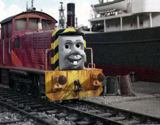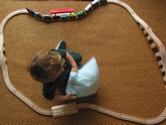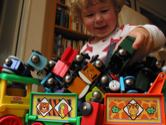It’s time to talk about Thomas the Tank Engine.
If you don’t have a young child, quick introduction: Thomas is based on a series of children’s books started in 1942 by the Rev. W. Awdry to entertain a sick young boy. Today, Thomas is a multi-million-dollar empire of books, wooden trains, and TV shows / videos. The Thomas universe consists of a group of engines and coaches living together on “The Island of Sodor” where they get into trouble, help one another, take pride in being “Really Useful,” learn important lessons about cooperation, bravery, friendship, and self esteem. What makes the Thomas railroad different from a “typical” children’s railroad is the fact that all of the engines and coaches have faces, personalities, strengths and weaknesses, modes of interaction that mimic (the better aspects of) society at large.
Unlike some kids’ shows, Thomas is aesthetically pleasing to parents, totally un-saccharine. The Thomas videos are beautifully shot and produced (featuring voiceovers by Ringo Starr, Alec Baldwin, George Carlin, others). The sets are elaborate, well-lit, clearly created by actual train lovers.
The thing about Thomas is that it has a tendency to make two-year-olds somewhat obsessive. Speaking from our own experience: Miles will play with Thomas trains for hours, then want to read Thomas stories before nap and bedtime, wants to watch Thomas on PBS when he wakes up in the morning, and will then go play with trains and tracks while reciting Thomas books from memory. He often wants to sleep with Thomas trains at night, and has even compared real-life situations to Thomas stories. From talking to other parents of boys, we know the obsession is not unusual (the fact that we have yet to meet a 2-4 year-old girl deeply into Thomas says all kinds of things about nature/nurture, but that’s for another day).
Fortunately, the obsession comes in waves. He does have other toys and other interests, and we try to encourage variety in his involvements, but it’s safe to say that the Thomas universe is a core element of his young life.
There are lots of good aspects to the obsession — when we play trains with him, he’s talking about how this engine or that needs help, finding creative ways to make sure the trains are cooperating, scolding trains who block the tracks or knock down bridges, coaxing cows off the tracks to make sure they don’t get ow-ies, “talking” the trains so that one is giving compliments to another… there’s a whole sociological microcosm going on here.
Of course, the machine that sits behind the Thomas empire is making a mint off parents like us (engines and coaches start at $8 and go up to $20, and a wide array of tracks, stations, bridges and accessories are sold to milk the parents of truly obsessed children.) In reality, children are being exposed to their first “brand,” being encouraged into a Great American Life of desire and consumerism without any comprehension of money, marketing, etc.
Recently had a debate with friends about whether the form of marketing that sells Thomas is insidious or damaging to young psyches – I maintain that Thomas is successful because it’s good, not because it’s marketed — the child’s obsession flows from the quality of the product and the stories themselves, not from a marketing machine that works to convince the child that s/he should want something s/he wouldn’t want otherwise. In other words, the desire is organic rather than synthetic; Thomas is marketed, but it’s not pushed. “Let the products sell themselves,” as The Minutemen’s D. Boone once said.
It’s not like I don’t have misgivings about the marketing machine behind Thomas. But at the same time, I know that Miles is not having crap shoved down his throat by the Thomas empire. He doesn’t perceive the marketing, he perceives the characters and the stories, gets a lot out of them. As parents, we may know that it takes some form of marketing to make a brand successful. But what Miles is exposed to is a collection of stories, not advertising. He is not having the experience of marketers trying to convince him to choose Thomas over some alternative, trying to sell him Nike rather than Adidas, or to use some shampoo just like all the rest. No one is suggesting to him that all the cool kids are into Thomas. We haven’t encouraged the Thomas obsession – we’ve only responded to his love for the characters. And I’m okay with that.
Pictured: Salty the diesel engine (who works down by the docks, sings sea shanties, and happens to be daddy’s favorite); Miles hard at work on the Island of Sodor; Emily, the fast, strong, and sensible female role model; choo-choo dogpile with the Little People Zoo Train.





Is the marketing that creates shows (conviently that have characters that look like toys themselves) and then creates and sells toys that look like the characters from those toys ‘evil’?
It’s an interesting thing to discuss. As a kid even into my preteens I didn’t feel like I was being seduced into thinking Transformers and GI Joe were cool they just were.
Marketing isn’t bad unless it’s hypocritical, meaning I can’t get shoes from Nike with “Made by Hiung Chi – Age 12” embroidered on them when they offer a service to do embroidery at my cost and don’t let me put on what I want it to say, even to crititcize their company. Also we’re older now, we’ve grown up with marketing fused with TV (and now internet) more so than our parents did. While I love the new addidas commercial by Spike Jonz I’m not going to buy 200$ shoes that supposedly develop orthotics over their lifetime because for 100$ I can buy custom orthotics that can go in any shoe because SHOES ARE DISPOSABLE, which is an environmental debate for another time.
Ultimately I think it comes down to imagination vs regurgitation. I mean, Lego has been going through this the past few years, they created the Bionocle series just because it’s a more ‘story driven’ type of block. Lego can produce books, shows and direct to dvd movies based on this series and it sells better than their basic block sets. Why? Because kids watch so much TV now that they don’t flex the part of their brains (as much because they of course can put the characters they know into new and different environments/stories of their own creation) as they used to. Kids don’t have the desire to pretend a square building they’ve made with the ‘plain’ lego blocks is a house or ship when they can get a set that is made specifically for that or so it seems to me.
I’ve thought a lot about giving up the TV as painful as it would be when Missy and I have kids, for a kid with an imagination a stick can be a sword one day and a laser rifle the next. A plastic molded train is always a train even if it is one of the better toys out there.
You know, I was going to post about Lego too. Got beaten to it.
I remember growing up in a world of all kinds of fun. I once sat on a rock, pointing a wooden cross-bar I’d made with a hammer and an old nail up at the sky, firing my ‘laser beams’ into the sun. I made my own bows and arrows and ran around the bush behind our house (I did grow up in the Blue Mountains though so there was a lot of scope for this kind of thing).
And I read good books.
I loved lego though. We’d yearly visit a big lego exhibition where they’d have these huge lego structures made up with statistics on how long they took to build and how many bricks etc. It was inspiring – but I didn’t feel targetted by marketing (I guess it was subtle). I used to spend hours making and remaking my lego things. Maybe that was why I finally became an engineer – making things was fun (sad that nobody told me that most engineers in Australia don’t make squat!)
I don’t think the kind of marketing you’re talking about is evil or malicious in any way, Scot. It’s branding — which basically means, making a product (or line of products) consistent enough so that it becomes recognizeable and familiar to people who use it. Good branding is essentially nothing more than that — consistency — and it’s what makes worlds like that of Thomas the Tank Engine possible. Sesame Street also has it, so do the Teletubbies, so for that matter does the Chronicles of Narnia or the Hardy Boys.
What’s more pernicious, I think, is advertising … which we’ve worked very hard to teach Clara about. Whenever commercials come on TV, for instance, during the rare times that we’re watching it, we make sure to explain that commercials are trying to convince you to buy something, and that they will tell you lies in order to do that. My hope is that if she’s well equipped to detect the sales pitch, Clara will be a savvier media consumer (and hopefully less susceptible to the lies).
Dylan, you’ve hit the nail on the head of the distinction I’m making, and in fact some of those same examples (Sesame Street, etc.) came up in the discussion I had with friends on this. I don’t have any problem with the branding of Sesame Street, Thomas, and others, but some were making the case that branding is itself a subtle means of getting into a child’s skull and filling them with desire for things. But as you say, these story universes would not be possible at all without some level of branding and the consistency it provides. Bottom line is, I don’t think branding is pernicious, while advertising is.
Ooh some good posts here since my last view and I see your point about making a stable universe/brand vs trying to sell it.
Also there were commercials here in WA for this and remembered your post so thought I’d link it since there are some dates for CA.
A Day Out With Thomas
Not that they’re selling this ;o) – That was a joke, honest.
Thanks Les! Yeah, we’ve seen pics of the full-scale Thomas before. Ironic or not, we may actually venture out to Felton to do this with Miles :)
Funny, I have a 2 year old dauhter and she loves trains and watching thomas the choo choo; shes far from obssessed, though.